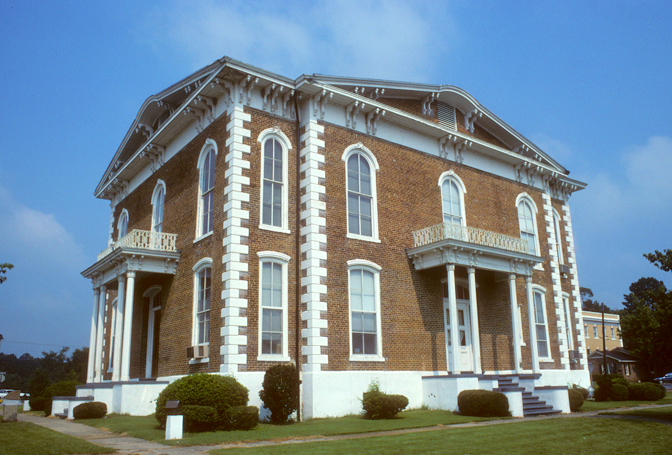Deep in the heart of Alabama, where winding country roads meet classic Southern charm, sits a courthouse unlike any other. The Pickens County Courthouse in Carrollton is more than just a civic institution—it’s a legendary landmark with a mysterious twist. While it serves as a functioning governmental building, it’s also known far and wide for a chilling tale that has intrigued historians, locals, and paranormal enthusiasts for over a century. Whether you’re a history buff curious about post-Civil War Southern architecture or a ghost hunter on the trail of restless spirits, the Pickens County Courthouse promises a spine-tingling adventure wrapped in historical intrigue.
The History
Birth of a Southern Landmark
The original Pickens County Courthouse was built in the early 1800s, soon after the establishment of Pickens County in 1820. Carrollton became the county seat in 1830, and the town quickly grew into an administrative central hub for the region. However, the courthouse we see today wasn’t the first—it’s actually the third.
The first courthouse, a modest wooden structure, succumbed to a fire in the mid-19th century. It was replaced by a more substantial building constructed in the 1850s, but that too met a fiery end during the turmoil following the Civil War. The cause of the fire remains a mystery, and some even suggest that it was an act of arson stemming from political and racial tensions of the era.
Rebuilding with Purpose
In 1877, the current Pickens County Courthouse was completed. Built from sturdy red brick and featuring elements of Greek Revival architecture, the new structure stood as a symbol of resilience and restoration in the post-Reconstruction South. Prominently located in the heart of Carrollton, it served not just as a courthouse but as a beacon of law and order in a region slowly piecing itself back together after years of conflict.
Yet, as beautiful and historic as it is, the real reason this courthouse gained national attention has less to do with its architecture and far more to do with a chilling legend etched into one of its upper-floor windows.
The Haunt
The Face in the Window
If you ask locals—or really, anyone interested in Southern ghost stories—they’ll tell you about the ghostly visage that peers out from the top floor of the Pickens County Courthouse. Known simply as “The Face in the Window,” this spectral image is believed to be the ghost of Henry Wells, an African American man accused of burning down the previous courthouse.
As the legend goes, Henry Wells was arrested in the early 1870s for burglary, but suspicion soon turned to him regarding the courthouse fire. A lynch mob formed, and authorities locked Wells in the attic of the newly constructed courthouse to keep him safe. Angry crowds gathered outside, demanding vigilante justice. As the storm raged, Wells supposedly looked out from the upstairs window and warned the mob that if he were executed unjustly, his face would remain in that window forever as a reminder.
Lightning struck moments later, and Wells was found dead—either from lynching, a stroke caused by fear, or some other mysterious cause depending on who tells the story. But in the days that followed, townspeople noticed something odd: a face seemingly burned into the glass of the very window he had looked through. Despite all efforts—it was scrubbed, replaced, and even painted over—the face kept reappearing.
Is It Real?
Skeptics suggest the image is simply a mineral deposit or stain amplified by local lore, but others—especially ghost hunters—believe it marks genuine paranormal activity. Several paranormal investigators have visited the site, using everything from EMF readers to spirit boxes. Many report unexplained cold spots on the upper floor, equipment malfunctions near the window, and a heavy, oppressive feeling when standing inside that part of the building.
Local lore claims that even during bright, sunny days, the face is unmistakably visible from outside. It has become a rite of passage for visiting ghost hunters to photograph the window, hoping to catch their own glimpse of the eerily preserved visage of Henry Wells.
Public Access and Paranormal Investigations
Because the Pickens County Courthouse is still in use, interior access can be a bit limited. However, the exterior is easily viewed from the town square, and guided tours are occasionally available during special events or by request. Paranormal societies periodically host nighttime investigations with permission from local officials, adding credibility to the courthouse’s status as one of Alabama’s most haunted sites.
Visitors often describe the town of Carrollton as warm and welcoming, but the courthouse itself carries a different energy. Whether you believe in spirits or not, standing in the shadow of history—and perhaps something more—is a sobering experience.
Conclusion: Dare to Witness
There are countless courthouses dotting the landscape of the American South, but few offer the eerie allure of the Pickens County Courthouse in Carrollton, Alabama. Rooted in deep historical significance and laced with one of the most enduring ghost stories in the South, this landmark invites you to step into a tale that is both unsettling and unforgettable.
Whether you’re a seasoned paranormal investigator or a curious traveler hunting your next haunted destination, the courthouse offers a compelling blend of fact and folklore. Bring your camera, open your mind, and don’t forget to look up. That faint outline in the upstairs window? It just might be Henry Wells, still watching, waiting, and reminding all who pass that some stories are not so easily buried.
So pack your gear, charge your EMF detector, and make your way to Pickens County—you never know what you might find staring back at you from the shadows of history.

